Wai Keung Wong
Task-Augmented Cross-View Imputation Network for Partial Multi-View Incomplete Multi-Label Classification
Sep 12, 2024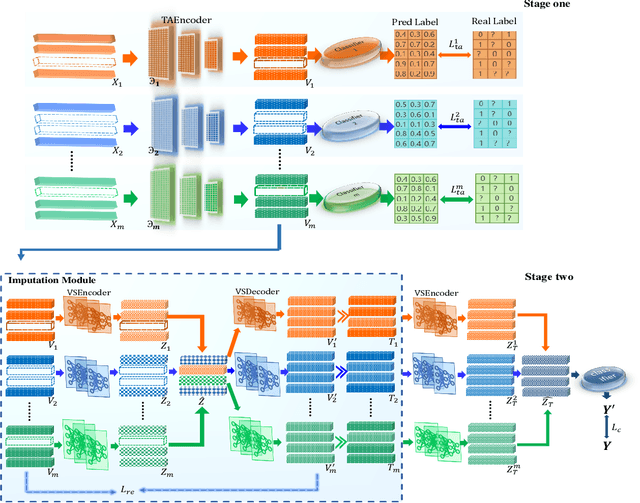
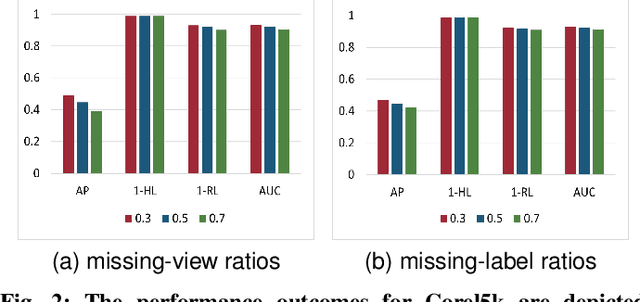
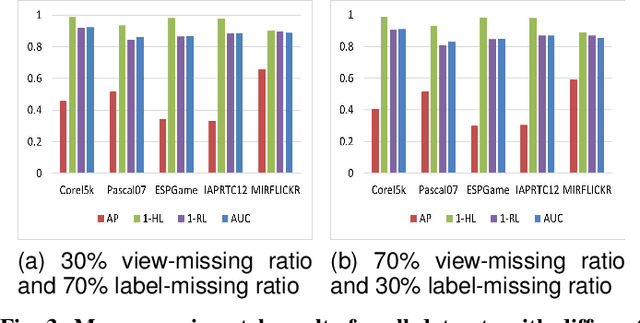
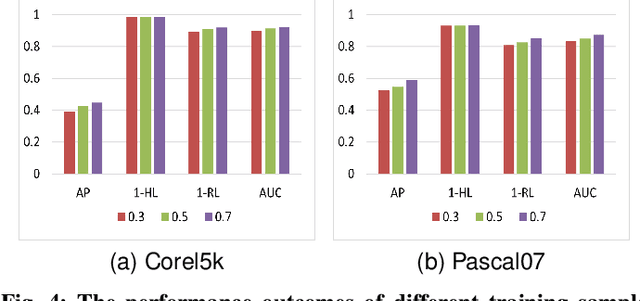
Abstract:In real-world scenarios, multi-view multi-label learning often encounters the challenge of incomplete training data due to limitations in data collection and unreliable annotation processes. The absence of multi-view features impairs the comprehensive understanding of samples, omitting crucial details essential for classification. To address this issue, we present a task-augmented cross-view imputation network (TACVI-Net) for the purpose of handling partial multi-view incomplete multi-label classification. Specifically, we employ a two-stage network to derive highly task-relevant features to recover the missing views. In the first stage, we leverage the information bottleneck theory to obtain a discriminative representation of each view by extracting task-relevant information through a view-specific encoder-classifier architecture. In the second stage, an autoencoder based multi-view reconstruction network is utilized to extract high-level semantic representation of the augmented features and recover the missing data, thereby aiding the final classification task. Extensive experiments on five datasets demonstrate that our TACVI-Net outperforms other state-of-the-art methods.
Effective Transfer of Pretrained Large Visual Model for Fabric Defect Segmentation via Specifc Knowledge Injection
Jun 28, 2023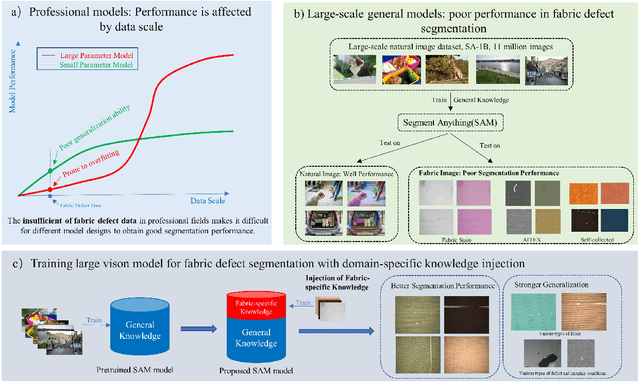
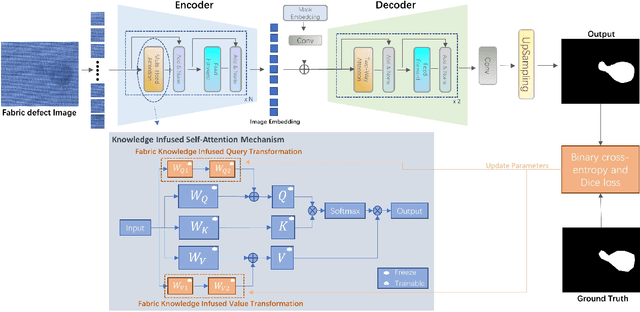
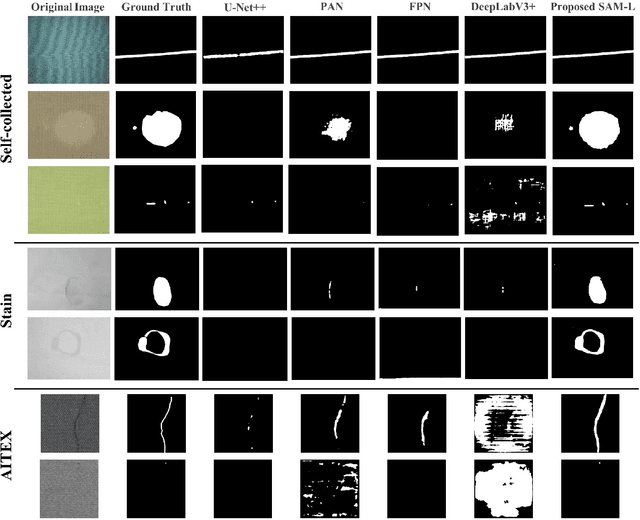

Abstract:Fabric defect segmentation is integral to textile quality control. Despite this, the scarcity of high-quality annotated data and the diversity of fabric defects present significant challenges to the application of deep learning in this field. These factors limit the generalization and segmentation performance of existing models, impeding their ability to handle the complexity of diverse fabric types and defects. To overcome these obstacles, this study introduces an innovative method to infuse specialized knowledge of fabric defects into the Segment Anything Model (SAM), a large-scale visual model. By introducing and training a unique set of fabric defect-related parameters, this approach seamlessly integrates domain-specific knowledge into SAM without the need for extensive modifications to the pre-existing model parameters. The revamped SAM model leverages generalized image understanding learned from large-scale natural image datasets while incorporating fabric defect-specific knowledge, ensuring its proficiency in fabric defect segmentation tasks. The experimental results reveal a significant improvement in the model's segmentation performance, attributable to this novel amalgamation of generic and fabric-specific knowledge. When benchmarking against popular existing segmentation models across three datasets, our proposed model demonstrates a substantial leap in performance. Its impressive results in cross-dataset comparisons and few-shot learning experiments further demonstrate its potential for practical applications in textile quality control.
OTFace: Hard Samples Guided Optimal Transport Loss for Deep Face Representation
Mar 28, 2022



Abstract:Face representation in the wild is extremely hard due to the large scale face variations. To this end, some deep convolutional neural networks (CNNs) have been developed to learn discriminative feature by designing properly margin-based losses, which perform well on easy samples but fail on hard samples. Based on this, some methods mainly adjust the weights of hard samples in training stage to improve the feature discrimination. However, these methods overlook the feature distribution property which may lead to better results since the miss-classified hard samples may be corrected by using the distribution metric. This paper proposes the hard samples guided optimal transport (OT) loss for deep face representation, OTFace for short. OTFace aims to enhance the performance of hard samples by introducing the feature distribution discrepancy while maintain the performance on easy samples. Specifically, we embrace triplet scheme to indicate hard sample groups in one mini-batch during training. OT is then used to characterize the distribution differences of features from the high level convolutional layer. Finally, we integrate the margin-based-softmax (e.g. ArcFace or AM-Softmax) and OT to guide deep CNN learning. Extensive experiments are conducted on several benchmark databases. The quantitative results demonstrate the advantages of the proposed OTFace over state-of-the-art methods.
Leveraging Two Types of Global Graph for Sequential Fashion Recommendation
May 30, 2021



Abstract:Sequential fashion recommendation is of great significance in online fashion shopping, which accounts for an increasing portion of either fashion retailing or online e-commerce. The key to building an effective sequential fashion recommendation model lies in capturing two types of patterns: the personal fashion preference of users and the transitional relationships between adjacent items. The two types of patterns are usually related to user-item interaction and item-item transition modeling respectively. However, due to the large sets of users and items as well as the sparse historical interactions, it is difficult to train an effective and efficient sequential fashion recommendation model. To tackle these problems, we propose to leverage two types of global graph, i.e., the user-item interaction graph and item-item transition graph, to obtain enhanced user and item representations by incorporating higher-order connections over the graphs. In addition, we adopt the graph kernel of LightGCN for the information propagation in both graphs and propose a new design for item-item transition graph. Extensive experiments on two established sequential fashion recommendation datasets validate the effectiveness and efficiency of our approach.
Reproducibility Companion Paper: Knowledge Enhanced Neural Fashion Trend Forecasting
May 25, 2021

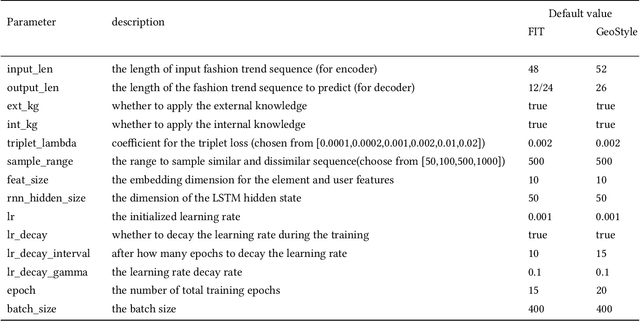

Abstract:This companion paper supports the replication of the fashion trend forecasting experiments with the KERN (Knowledge Enhanced Recurrent Network) method that we presented in the ICMR 2020. We provide an artifact that allows the replication of the experiments using a Python implementation. The artifact is easy to deploy with simple installation, training and evaluation. We reproduce the experiments conducted in the original paper and obtain similar performance as previously reported. The replication results of the experiments support the main claims in the original paper.
Leveraging Multiple Relations for Fashion Trend Forecasting Based on Social Media
May 11, 2021



Abstract:Fashion trend forecasting is of great research significance in providing useful suggestions for both fashion companies and fashion lovers. Although various studies have been devoted to tackling this challenging task, they only studied limited fashion elements with highly seasonal or simple patterns, which could hardly reveal the real complex fashion trends. Moreover, the mainstream solutions for this task are still statistical-based and solely focus on time-series data modeling, which limit the forecast accuracy. Towards insightful fashion trend forecasting, previous work [1] proposed to analyze more fine-grained fashion elements which can informatively reveal fashion trends. Specifically, it focused on detailed fashion element trend forecasting for specific user groups based on social media data. In addition, it proposed a neural network-based method, namely KERN, to address the problem of fashion trend modeling and forecasting. In this work, to extend the previous work, we propose an improved model named Relation Enhanced Attention Recurrent (REAR) network. Compared to KERN, the REAR model leverages not only the relations among fashion elements but also those among user groups, thus capturing more types of correlations among various fashion trends. To further improve the performance of long-range trend forecasting, the REAR method devises a sliding temporal attention mechanism, which is able to capture temporal patterns on future horizons better. Extensive experiments and more analysis have been conducted on the FIT and GeoStyle datasets to evaluate the performance of REAR. Experimental and analytical results demonstrate the effectiveness of the proposed REAR model in fashion trend forecasting, which also show the improvement of REAR compared to the KERN.
* 12 pages, 8 figures
Knowledge Enhanced Neural Fashion Trend Forecasting
May 07, 2020



Abstract:Fashion trend forecasting is a crucial task for both academia and industry. Although some efforts have been devoted to tackling this challenging task, they only studied limited fashion elements with highly seasonal or simple patterns, which could hardly reveal the real fashion trends. Towards insightful fashion trend forecasting, this work focuses on investigating fine-grained fashion element trends for specific user groups. We first contribute a large-scale fashion trend dataset (FIT) collected from Instagram with extracted time series fashion element records and user information. Further-more, to effectively model the time series data of fashion elements with rather complex patterns, we propose a Knowledge EnhancedRecurrent Network model (KERN) which takes advantage of the capability of deep recurrent neural networks in modeling time-series data. Moreover, it leverages internal and external knowledge in fashion domain that affects the time-series patterns of fashion element trends. Such incorporation of domain knowledge further enhances the deep learning model in capturing the patterns of specific fashion elements and predicting the future trends. Extensive experiments demonstrate that the proposed KERN model can effectively capture the complicated patterns of objective fashion elements, therefore making preferable fashion trend forecast.
 Add to Chrome
Add to Chrome Add to Firefox
Add to Firefox Add to Edge
Add to Edge